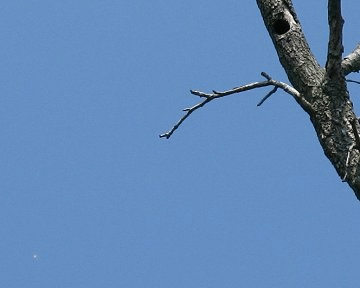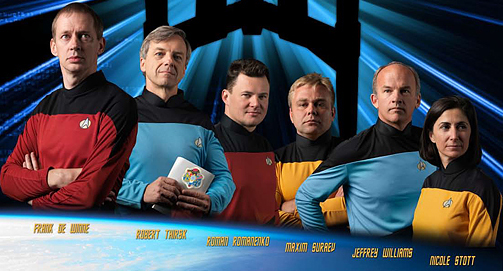|
|||||||
|
|
|
 |
|
|
Strumenti |
|
|
#141 |
|
Senior Member
Iscritto dal: Feb 2004
Città: Torino
Messaggi: 3236
|
Infatti oggi non sarebbe possibile mandare su un nuovo Skylab nemmeno volendo: manca un vettore super pesante in grado di portarlo su. Chissà un domani con Ares V..
|
|
|

|
|
|
#142 | |
|
Senior Member
Iscritto dal: Apr 2006
Messaggi: 1464
|
Si va verso una sostituzione del radiatore che si è delaminato (foto nell'articolo):
Quote:
|
|
|
|

|
|
|
#143 | |
|
Senior Member
Iscritto dal: Apr 2006
Messaggi: 1464
|
Quote:
|
|
|
|

|
|
|
#144 | |
|
Senior Member
Iscritto dal: Apr 2006
Messaggi: 1464
|
Quote:
|
|
|
|

|
|
|
#145 |
|
Senior Member
Iscritto dal: Jun 2002
Città: Mestre (VE)
Messaggi: 458
|
leggermente OT: è un mesetto che provo a contattarli via radio in packet ma non riesco ad agganciarli... sapete se hanno spento la parte radio o cosa?
__________________
(\_/) (°_°) FELICEMENTE COGLIONE- da oggi anche INDEGNO DI ESSERE ITALIANO! (> <) "Questo è un ribaltamento della realtà" 
|
|
|

|
|
|
#146 | |
|
Senior Member
Iscritto dal: Apr 2006
Messaggi: 1464
|
Quote:
|
|
|
|

|
|
|
#147 | |
|
Senior Member
Iscritto dal: Apr 2006
Messaggi: 1464
|
Da segnalare inoltre:
- Il Nodo 3 è stato spedito da Torino al KSC Quote:
|
|
|
|

|
|
|
#148 | ||
|
Senior Member
Iscritto dal: Apr 2006
Messaggi: 1464
|
Quote:
Quote:
Ultima modifica di Rand : 27-05-2009 alle 14:33. |
||
|
|

|
|
|
#149 | |
|
Senior Member
Iscritto dal: Apr 2006
Messaggi: 1464
|
 Quote:
|
|
|
|

|
|
|
#150 |
|
Senior Member
Iscritto dal: Jun 2002
Città: Mestre (VE)
Messaggi: 458
|
evvai ora che sono il doppio magari ogni tanto risponderanno via radio
__________________
(\_/) (°_°) FELICEMENTE COGLIONE- da oggi anche INDEGNO DI ESSERE ITALIANO! (> <) "Questo è un ribaltamento della realtà" 
|
|
|

|
|
|
#151 | |
|
Senior Member
Iscritto dal: Mar 2001
Messaggi: 1910
|
Quote:
E poi chissà, nel 2020 si vedrà.... la mir è durata il doppio del periodo, anche se poi alla fine i guasti erano sempre più frequenti. |
|
|
|

|
|
|
#152 |
|
Senior Member
Iscritto dal: Feb 2002
Messaggi: 7072
|
Mi era già stato chiarito che il costo "intrinseco" delle operazioni possibili sulla ISS è minore rispetto ad un equivalente su modello skylab
|
|
|

|
|
|
#153 | |
|
Senior Member
Iscritto dal: Apr 2006
Messaggi: 1464
|
Saggese ha suggerito la possibilità di utilizzare l'MPLM che verrà (probabilmente) lasciato permanentemente sulla ISS come laboratorio e non solo come "magazzino":
Quote:
|
|
|
|

|
|
|
#154 | |
|
Senior Member
Iscritto dal: Apr 2006
Messaggi: 1464
|
Altro contratto per Thales Alenia Space:
Quote:
|
|
|
|

|
|
|
#155 | |
|
Senior Member
Iscritto dal: Apr 2006
Messaggi: 1464
|
A quanto sembra nelle giuste condizioni la ISS ora è visibile anche di giorno!
 Quote:
|
|
|
|

|
|
|
#156 |
|
Senior Member
Iscritto dal: Apr 2006
Messaggi: 1464
|
|
|
|

|
|
|
#157 |
|
Senior Member
Iscritto dal: Mar 2002
Città: Treviso
Messaggi: 911
|
|
|
|

|
|
|
#158 |
|
Senior Member
Iscritto dal: Apr 2006
Messaggi: 1464
|
Per chi si fosse sempre domandato dove conservano i consumabili e gli altri materiali all'interno della ISS c'è un tour in HD dedicato.
|
|
|

|
|
|
#159 |
|
Senior Member
Iscritto dal: Nov 2003
Città: Utopia Planitia
Messaggi: 3875
|
Non sono aggiornati con le ultime disposizione della Flotta Stellare in materia di uniformi
__________________

|
|
|

|
|
|
#160 |
|
Senior Member
Iscritto dal: Apr 2006
Messaggi: 1464
|
|
|
|

|

|
| Strumenti | |
|
|
Tutti gli orari sono GMT +1. Ora sono le: 21:05.














 insistono!
insistono!










